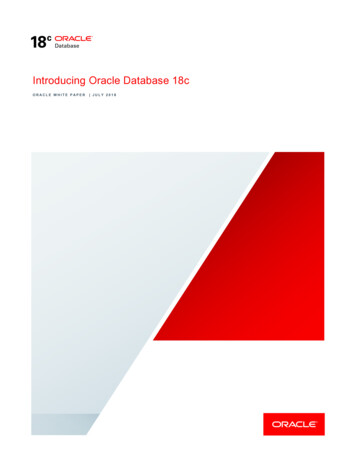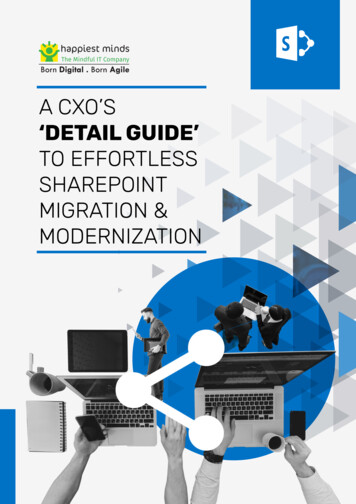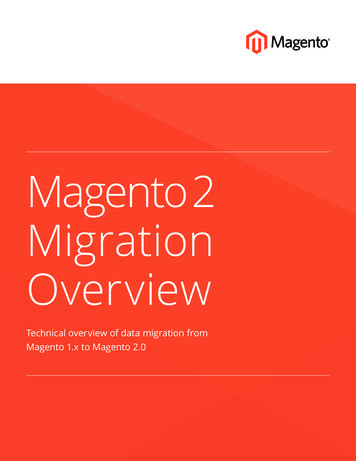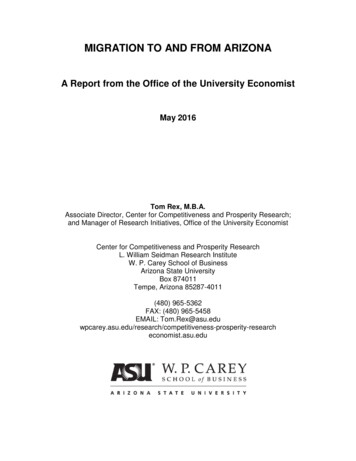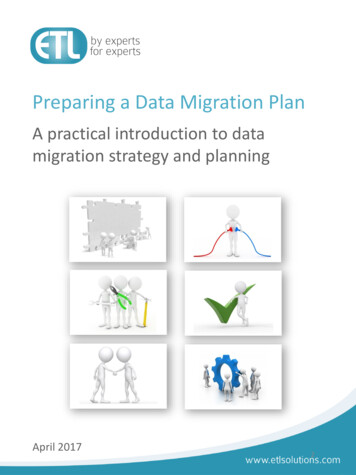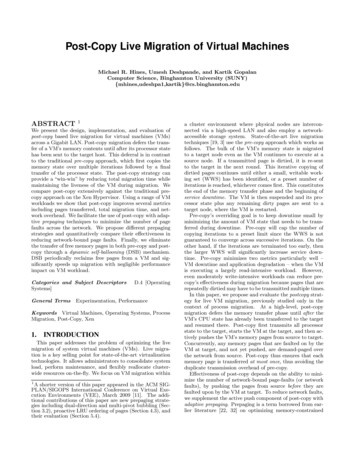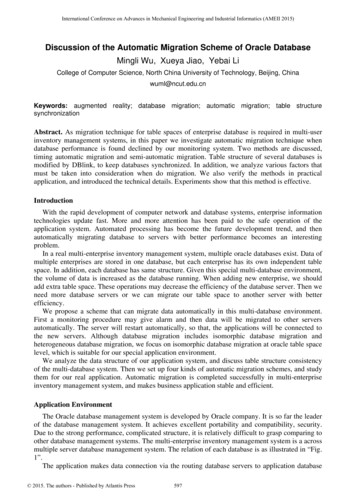
Transcription
International Conference on Advances in Mechanical Engineering and Industrial Informatics (AMEII 2015)Discussion of the Automatic Migration Scheme of Oracle DatabaseMingli Wu, Xueya Jiao, Yebai LiCollege of Computer Science, North China University of Technology, Beijing, Chinawuml@ncut.edu.cnKeywords: augmented reality; database migration; automatic migration; table structuresynchronizationAbstract. As migration technique for table spaces of enterprise database is required in multi-userinventory management systems, in this paper we investigate automatic migration technique whendatabase performance is found declined by our monitoring system. Two methods are discussed,timing automatic migration and semi-automatic migration. Table structure of several databases ismodified by DBlink, to keep databases synchronized. In addition, we analyze various factors thatmust be taken into consideration when do migration. We also verify the methods in practicalapplication, and introduced the technical details. Experiments show that this method is effective.IntroductionWith the rapid development of computer network and database systems, enterprise informationtechnologies update fast. More and more attention has been paid to the safe operation of theapplication system. Automated processing has become the future development trend, and thenautomatically migrating database to servers with better performance becomes an interestingproblem.In a real multi-enterprise inventory management system, multiple oracle databases exist. Data ofmultiple enterprises are stored in one database, but each enterprise has its own independent tablespace. In addition, each database has same structure. Given this special multi-database environment,the volume of data is increased as the database running. When adding new enterprise, we shouldadd extra table space. These operations may decrease the efficiency of the database server. Then weneed more database servers or we can migrate our table space to another server with betterefficiency.We propose a scheme that can migrate data automatically in this multi-database environment.First a monitoring procedure may give alarm and then data will be migrated to other serversautomatically. The server will restart automatically, so that, the applications will be connected tothe new servers. Although database migration includes isomorphic database migration andheterogeneous database migration, we focus on isomorphic database migration at oracle table spacelevel, which is suitable for our special application environment.We analyze the data structure of our application system, and discuss table structure consistencyof the multi-database system. Then we set up four kinds of automatic migration schemes, and studythem for our real application. Automatic migration is completed successfully in multi-enterpriseinventory management system, and makes business application stable and efficient.Application EnvironmentThe Oracle database management system is developed by Oracle company. It is so far the leaderof the database management system. It achieves excellent portability and compatibility, security.Due to the strong performance, complicated structure, it is relatively difficult to grasp comparing toother database management systems. The multi-enterprise inventory management system is a acrossmultiple server database management system. The relation of each database is as illustrated in “Fig.1”.The application makes data connection via the routing database servers to application database 2015. The authors - Published by Atlantis Press597
servers. Each application database server has the same structure. To achieve automatic migration oftable space among application database servers, we store application database servers, connectioninformation in the routing database server. After the automatic migration, we should ensure that therouting information can be modified automatically. The applications can re-connect to thecorresponding table space of new database servers.Table spaceRouting database serverApplication ofdatabase server 1Table spaceApplication ofdatabase server 2Table space.Table spaceFigure 1. Database System ArchitectureOracle database migration technologyA. Oracle Migration Tools Expdp/Impdp: It can save the database as a binary format file under OS. It is irrelevant to theplatform.DBlink: It establishes a remote database link through the network to transfer data withindifferent database server quickly.RMAN: It is mainly used as a tool to backup, restore and recovery database, migrate thedatabase and several of database files, and allow the backup in incremental block level.B. Database Migration SystemSince different enterprise originally used different databases, when we upgrade the system, wemaybe need in order to migrate the database. In order to solve this problem, we need to design adatabase migration system, to realize the transfer between different databases. The system connectsdifferent database systems; it can choose a different table and different fields in tables and achievethe conversion in table data type during migration. This migration mode is slow because oftransferring API to object and then to focus on the database format, so it is not suitable for largedata transmission.The model of migration system’s data conversion is as illustrated in “Fig. 2”.C. Import SQL ScripsThis scheme realizes the database replication by execution of the SQL script. The features of thismigration are those: poor database integrity, poor expansibility, not very flexible, but quickly thetimeliness, and of better isomorphic database applications.Considering the characteristics of database migration methods above, in order to realize theautomatic migration we combine the application software system and SQL scripts threaded tocomplete the migration. We realise the links within different databases with DBlink, thencompletion of the database migration within different servers fast and efficiently. In order to makeup for the questions as poor expansibility, not very flexible, caused of database script transfer, wejudge the dynamic call SQL scripts to perform automatic migration according to the applicationsoftware monitoring results; at the same time in order to make up for the questions as poor integrity ,caused of the database script migration, after migrating, to ensure the integrity of the databasemigration, we use the application of software to verify the consistency of the database.598
The sourcedatabaseAPIApplicationsoftware programobjectAPIThe targetdatabaseFigure 2. The conversion model of dataAutomatic Migration related TechnologyA.Timer MethodAutomatic migration means that there is no manual intervention. When the conditions are met,the database system can automatically perform database migration. So in order to achieve automaticmigration, you must have an event which can automatically trigger an automatic migration method.The current can trigger the automatic migration method has two ways:1)Windows-based Automatic Timing MethodWindows timer prototype is that:WINSERAPI UINT WINAPI SetTimer(HWND hwnd, UINT nIDFlag, UINT uTime,TIMERPROC timerFunc); hwnd: A desire to set the timer window handles. Regular time, the system will send aWM TIMER message to the form. nIDFlag: Timer identifier. You can use multiple timers in a window of the body, according tonIDFlag to distinguish different timers. uTime: Regular time, in milliseconds. timerFunc: Timer callback function. If the value is NULL, regular time to time, the messageWM TIMER sent by timer the default function will process the message; otherwise processedby the callback function.2)Oracle Timer MethodOracle Timer general for operating various tables, views, and stored procedures, we usuallycreate a stored procedure. To the timing of the implementation of the stored procedure through thetimer, the stored procedure is usually some operations on the table or view. Its structure is asfollows:a) declareb) job number;c) begin dbms job.submit(d) jobnum,e) 'PRC INSERT;',f) sysTime,g) 'sysdate a/b'h) );i) commit;j) end;The a-c line: Express the statement of the timer job;The d line: Timer ID, the system can get automatically;The e line: The name of the stored procedure execution;The f line: The timer starts execution time, sysTime means immediate execution;The g line: Interval, set the frequency of the timer execution;The h-j line: Express the ending of the timer job.Windows timer which was used in VC frequently, and is in a large number of table-leveloperations. It is recommended to use the database itself timer job, which is more convenient, high599
efficiency; another if a system-level timer, which is too dependent on the system, in addition to alot of programming work will increase, and cost increased, is very easy to make mistakes; thingsmore simple the less chance of error. Therefore, the system triggers automatic migration is to usethe Oracle database itself timer to trigger automatic migration.B.Hot Backup and Incremental BackupHot backup is under the condition of the database operation, adopt the Archivelog mode methodto back up the database. That hot backup is that system is in normal operation state and backup thedatabase. So, if you had last night a cold backup and today's hot backup files, in the event of aproblem, you can use these data in recovery for more information. Hot backup requires the databasein Archivelog mode, and requires a lot of file space. Once the database is running in Archivelogmode, you can make a backup. Sometimes, we will be online data backup is called hot backup, andthe off-line data backup is called a cold backup, to distinguish two different backup concepts. Theywill do more data compression to the existing memory, by reducing access to the hard disk (calledvirtual memory) method to solve the problem.1) The advantages of hot backupa) In the table space or the database file backup, backup time is short;b) During the backup time the database can still use;c) Level recovery can reach second level(restored to a certain time point);d) It can do recovery for almost all database entity;e) Recovery is fast, in most cases when the database is still work to recover.2) The disadvantages of hot backupa) It can't go wrong, otherwise the consequence is serious;b) If the hot backup is not successful, the results cannot be used for recovery to the point intime;c) Because of difficult to maintain, it should be especially careful, do not allow the "failed".(2)Incremental backup means that after the first full backup or incremental backup, then eachbackup only once or increase compared with the previous file is modified. After each backup onlyback up the files that simply compared with the previous increase or modified; the secondincremental backup objects are the incremental backup increase and modified files after the firsttime, and so on. The most significant advantage of this backup method is that there is no duplicationof backup data, the backup data volume is not big, and the backup time is short.Analyzing the characteristic of hot backup and incremental backup, concluded that can combinehot backup and incremental backups to implement backup database. First, we can back up thewhole online database; then we will increase the content of the database backup to another databaseat regular intervals. So that a backup of the online database can be timely backup; its technicalimplementation can use DML trigger. When the database is detected at risk, you can dynamicallylink to the backup of the database, realize the goal of automatic migration database.Automatic Migration Monitoring IndicatorsA.Monitoring IndicatorsDatabase migration, from the source and target databases composed, when the system achievesto migrate the source database monitoring indicators, choose a better performance of the targetdatabase migration. The following analysis is to monitor indicators of the source and targetdatabases.Source database: Table space counts, found through experiments, which a database can accommodate up to65,535 table spaces; A larger share of physical disks; CPU share of long-term 70% - 90%; Database monitoring alarm counts.Target database:600
Query each server database table space number; Smaller share of physical disks; CPU share is relatively low; Database monitoring alarm counts.Analysis of the above indicators, find the database cache hit rate and CPU time share is the resultof the analysis is not to do as an indicator of instantaneous data transfer, so to use the results of theanalysis period as an indicator of the migration of the database.B. Parametric Analysis1) CPU’s occupancy rate is in seconds and Data recorded at every 5s.As shown in “fig. 3”.CPU’s average value formula:NP ki 1iNFigure 3. CPU’s occupancyFigure 4. Alarm times2) Record number of database monitoring alarm and data recorded at every half an hour.Asshown in “fig. 4”:3) Monitoring these indicators, the average number of CPU’s occupancy and database cache hitrate recorded at every 2 hours. Database performance is calculated by the weighted average,monitoring indicators’s formula:0.8abM k1 k2 k4 k5 d655353cMeaning of the parameters:a: The number of tablespace, range oracle database tablespace for(0-65535)b: Disk usage ratec: CPU’s occupancy rate.Under normal circumstances ,CPU occupancy rate should be lessthan(70%-90%)d : The number of database’s alarm times,statistics is that this two-hour alarm timeski : Monitoring weight.Set different parameter values according to system specificcircumstances。601
Automatic Migration Scenario Selection 1. Instant - AutomaticWhen the migration conditions are met, immediately migration. 2. Instant - Semi-automaticWhen the migration conditions are met, the pop-prompt window will be existing. It will showwhether the migration immediately. Selecting “Yes” mean to migrate immediately; or selecting“No” mean jumps to “C”. 3. Timing - AutomaticWhen the migration conditions are met, migration timing open to 0:00 pm beginning themigration. 4. Timing - Semi-automaticWhen the migration conditions are met, then the pop-prompt window will show whether toopen the regular automatic migration. Clicking “Yes” means to jump “3”; clicking “No” means thatit will not migrate.Migration scenario analysis above can be drawn, “1” scheme is not practical, since “A” plan toorisky, it may lead to daytime running application software cannot be used temporarily and loss ofcustomer data running on the system too much influence. So the use of “2”, “3”, “4” program toautomatically migrate more appropriate.Automatic Database MigratIONDefinition of automatic is the ability to automatically migrate database timed, and delete theexisting database. Now design an automated migration scenarios, you can manually configure theautomatic migration scenarios. When the migration conditions are met, the program canautomatically perform the migration, migrate the database and can automatically restart the serverto achieve application software to connect to the new database server. At the same time in order toensure the consistency of each database system architecture, through DBlink links are linked toeach database, so that when you modify the table structure, and modify the other database tablestructure corresponding functional background management system. Its automated migrationprocess is as illustated in “fig. 5”.Data Consistency For MigrationWe need to verify the data when the data migration has been completed. The verification cancheck the quality of the data migration, while the results of data validation are an important basis tojudge whether the new system was officially used.We can verify the migrated data by the two ways. Comparing the old and new systems to checkthe data, to query the data of same indicators and compare the final query results with the querytools of old system and new system. The data of new system is recovered to the state of the oldsystem has not been migrated, and add the business data what happened on the last day on the oldsystem to the new system, then check for abnormalities and compare the final results with the oldsystem.By the data quality check tools or the specific inspection program, we can analyze the quality ofmigration data. It’s different from the quality analysis hasn’t migrated. The validation of migrationdata is mainly to check the different indicators. The indicator for the validation of migration dataincludes four areas. Integrity Check is to test whether the foreign key of references exists;consistency Check is to test whether the data values of the same meaning but at different locationsare same; record Check is to test whether the number of corresponding new system and old systemis same. Special Sample Data Check is to test whether the new database and the old database issame, which is achieved by randomly comparing record of one day.602
StartMonitorMeet themigrationconditionNYStop the connection tothe application serverAutomaticmigrationVerificationconsistency aftermigrationNYDelete thesource databaseDelete thetarget databasefailAutomaticrestart theserversuccessFigure 5. The process of automated migrationAutomatic Migration ReportIn the migration process, resulting in migration failure due to a hardware problem. networktransmission problems, or the script is not executed problem. In order to ensure data security, everystep of the automatic migration need to be monitored and recorded, so we require to record themigration process and the results of the migration. WeTABLE I.AttributeidstarttimeendtimeYipMipDATA REPORTTypeDescriptionNUMBERTIMETIMEStringStringthe primary keystart timeend timesource database ipTarget database ip603
YSLStringMSLStringResultBooleaninstance namesource databaseinstance nametarget databasetheresultsmigrationofofofdesign a report form(TABLE 1) for recording the migration operation.Multi-database structure synchronizationWe find in the process of data migration, because of the multi-database structure we need tomodify the structure of table of all the database if we need to modify some structure of a table. Itneeds manual operation and it’s easy to cause error. Based on this, we design an interface and takeadvantage of triggers principle and link the data of table with DBlink. It can trigger all the tablestructure when we modify some table structure. Then we can modify the less table and we canachieve it in the background. Now there are two ways which can achieve this goal.1)Modify the structure of tableWe can modify fields to change the structure of table and the field attributes in the database.2)Modify the SQLWe can use SQL to modify the structure of table. We use DBlink to link all the database, it cankeep all the structure of table consistent in the database.ConclusionWith the quickly development of database technology, data information becomes valuable formost enterprises and database migration has been an important task. Based on all the migrationmethod, our paper take advantage of them synthetically and combine the structure of oracledatabase. It’s the future trend of database migration that achieve the automatic migration bycombine the application system migration and scripts migration. In this paper we only discuss theautomatic migration of isomorphic database, and we plan to study automatic migration forheterogeneous database in future.AcknowledgementThis paper funded by: Scientific Research Project of Beijing Municipal Commission of Education(Project No: KM201410009008); Project of Construction of Innovative Teams and Teacher CareerDevelopment for Universities and Colleges Under Beijing Municipality(Project No. :IDHT20130502); Project of Construction of the central financial support for Universities andColleges (Project No.:P X M2014 014212 000097)Reference[1]LUO Linqiu,MENG Qi,LI Xiao and etc. Design and implementation of heterogeneousdatabase migration[J]. Application Research of Computers, 2006, 23(12):233-235.[2]XIONG Hui,LIU Yanfeng,GUO Daoqing. Design and implementation of distributedheterogeneous database migration system[J]. Computer Engineering, 2008, 34(4):57-59.[3]GAO Cuifen,HUANG Wei. oracle database migration solutions[J]. Electronic Technology& Software , 2013, (24):196-196.[4]HE Hui,SUN Fu,LI Sui. Data conversion model of heterogeneous database[J]. ComputerEngineering and Design, 2005, 26(9):2461-2463.604
[5]WANG Yutao. Oracle massive heterogeneous data platform (Windows platform migrationwill be migrated to SolarisX64 Oracle database platform)[J]. Telecom World, 2013, (7):66-67.[6]YANG Hanbing, ZHAO Long, JIA Jinyuan. Design and realization of HBase migrationtool[J].Computer Science and Technology, 2013, 7(3):236-246.[7]FANG Yinglan,CHENG Binghui,TANG Miao.Design and implementation of heterogeneousdatabase migration system based on JDBC[J]. Journal of North China University of Technology,2013, 25(1):5-10.[8]ZHANG Xiao,ZHANG Yu. Research on remote database migration[J]. ApplicationResearch of Computers, 2005, 22(4):106-108.[9]TANG Liuhua,MA Yonqiang,LI Chunfu. Dual hot backup system based on TCP protocol[J].Information Security and Communications Privacy, 2006, (8):173-175.[10] ZHENG Xiangyun,ZHANG Juan,GE Wengeng. Design and implementation of databasesynchronization in data capture differences[J].Computer Knowledge and Technology, 2009,5(7):1544-1545.605
Oracle database migration technology . A. Oracle Migration Tools Expdp/Impdp: It can save the database as a binary format file under OS. It is irrelevant tothe platform. DBlink: It establishesa remote database link through network to transfer data within the different database server quickly.



